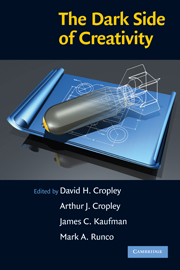Book contents
- Frontmatter
- Contents
- List of Contributors
- 1 The Dark Side of Creativity: What Is It?
- 2 Creativity Has No Dark Side
- 3 Positive Creativity and Negative Creativity (and Unintended Consequences)
- 4 Subjugating the Creative Mind: The Soviet Biological Weapons Program and the Role of the State
- 5 Imagining the Bomb: Robert Oppenheimer, Nuclear Weapons, and the Assimilation of Technological Innovation
- 6 The Innovation Dilemma: Some Risks of Creativity in Strategic Agency
- 7 Early Creativity as a Constraint on Future Achievement
- 8 Boundless Creativity
- 9 Reviewing the Art of Crime: What, If Anything, Do Criminals and Artists/Designers Have in Common?
- 10 Creativity in Confinement
- 11 Creativity and Crime: How Criminals Use Creativity to Succeed
- 12 So You Want to Become a Creative Genius? You Must Be Crazy!
- 13 Both Sides of the Coin? Personality, Deviance, and Creative Behavior
- 14 Neurosis: The Dark Side of Emotional Creativity
- 15 Dangling from a Tassel on the Fabric of Socially Constructed Reality: Reflections on the Creative Writing Process
- 16 Creativity in the Classroom: The Dark Side
- 17 The Dark Side of Creativity and How to Combat It
- 18 A Systems Engineering Approach to Counterterrorism
- 19 Malevolent Innovation: Opposing the Dark Side of Creativity
- 20 Summary – The Dark Side of Creativity: A Differentiated Model
- Index
- References
9 - Reviewing the Art of Crime: What, If Anything, Do Criminals and Artists/Designers Have in Common?
Published online by Cambridge University Press: 05 June 2012
- Frontmatter
- Contents
- List of Contributors
- 1 The Dark Side of Creativity: What Is It?
- 2 Creativity Has No Dark Side
- 3 Positive Creativity and Negative Creativity (and Unintended Consequences)
- 4 Subjugating the Creative Mind: The Soviet Biological Weapons Program and the Role of the State
- 5 Imagining the Bomb: Robert Oppenheimer, Nuclear Weapons, and the Assimilation of Technological Innovation
- 6 The Innovation Dilemma: Some Risks of Creativity in Strategic Agency
- 7 Early Creativity as a Constraint on Future Achievement
- 8 Boundless Creativity
- 9 Reviewing the Art of Crime: What, If Anything, Do Criminals and Artists/Designers Have in Common?
- 10 Creativity in Confinement
- 11 Creativity and Crime: How Criminals Use Creativity to Succeed
- 12 So You Want to Become a Creative Genius? You Must Be Crazy!
- 13 Both Sides of the Coin? Personality, Deviance, and Creative Behavior
- 14 Neurosis: The Dark Side of Emotional Creativity
- 15 Dangling from a Tassel on the Fabric of Socially Constructed Reality: Reflections on the Creative Writing Process
- 16 Creativity in the Classroom: The Dark Side
- 17 The Dark Side of Creativity and How to Combat It
- 18 A Systems Engineering Approach to Counterterrorism
- 19 Malevolent Innovation: Opposing the Dark Side of Creativity
- 20 Summary – The Dark Side of Creativity: A Differentiated Model
- Index
- References
Summary
The “dark side of creativity” is a slippery concept to explore because the idea of “creativity” is subject to historically changing definitions. This chapter will review some ideas about creativity and, when discussing the art of crime as the “dark side of creativity,” will try to avoid positioning “darkness” as “blindness, evil, lack, loss and as the underworld” compared with “light” as “clarity, hope, goodness, rebirth and life.” Such stark oppositions often contain quasi-religious meanings, as exemplified by the Star Wars movies (“Yes, a Jedi's strength flows from the force. … But beware the desire of the dark side”). Instead, we will discuss the dark side of creativity by
Reviewing definitions of creativity and examining dyslexia and what else artists, designers, criminals, and entrepreneurs have in common (Gamman, 2008a)
Further explaining how and why ideas about the dark side of creativity are relevant to understanding the emergence of the Design Against Crime Research Centre (DACRC) located at the University of the Arts London – in particular, to understand approaches to design creativity defined as “thinking thief” (Ekblom, 1997) as well as the “criminal gaze” (Gamman, 2008b)
Finally, discussing how and why ideas about the “the art of crime”, as well as actual crime itself, have informed the discourse of transgression associated with art and design, informing a number of creative outputs that we review
- Type
- Chapter
- Information
- The Dark Side of Creativity , pp. 155 - 176Publisher: Cambridge University PressPrint publication year: 2010
References
- 6
- Cited by

